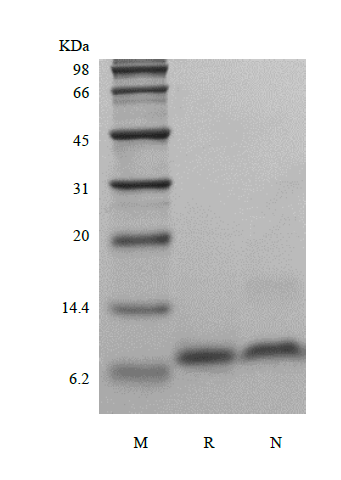- Synonyms
- EPG, Epithelial Mitogen
- Source
- Escherichia coli.
- Molecular Weight
- Approximately 7.9 kDa monomeric protein, containing 72 amino acid residues, which comprises the EGF homologous portion of the Epigen precursor.
- AA Sequence
- AVTVTPPITA QQADNIEGPI ALKFSHLCLE DHNSYCINGA CAFHHELEKA ICRCFTGYTG ERCEHLTLTS YA
- Purity
- > 98 % by SDS-PAGE and HPLC analyses.
- Biological Activity
- Fully biologically active when compared to standard. The ED50 as determined by a cell proliferation assay using murine Balb/c 3T3 cells is less than 300 ng/ml, corresponding to a specific activity of > 3.3 × 103 IU/mg.
- Physical Appearance
- Sterile Filtered White lyophilized (freeze-dried) powder.
- Formulation
- Lyophilized from a 0.2 μm filtered concentrated solution in PBS, pH 7.4.
- Endotoxin
- Less than 1 EU/μg of rHuEpigen as determined by LAL method.
- Reconstitution
- We recommend that this vial be briefly centrifuged prior to opening to bring the contents to the bottom. Reconstitute in sterile distilled water or aqueous buffer containing 0.1 % BSA to a concentration of 0.1-1.0 mg/mL. Stock solutions should be apportioned into working aliquots and stored at ≤ -20 °C. Further dilutions should be made in appropriate buffered solutions.
- Stability & Storage
- Use a manual defrost freezer and avoid repeated freeze-thaw cycles.
- 12 months from date of receipt, -20 to -70 °C as supplied.
- 1 month, 2 to 8 °C under sterile conditions after reconstitution.
- 3 months, -20 to -70 °C under sterile conditions after reconstitution.
- Usage
- This material is offered by Shanghai PrimeGene Bio-Tech for research, laboratory or further evaluation purposes. NOT FOR HUMAN USE.
- SDS-PAGE

- Reference
- 1. Strachan L, Murison JG, Prestidge RL, et al. 2001. J Biol Chem, 276: 18265-71.
2. Kochupurakkal BS, Harari D, Di-Segni A, et al. 2005. J Biol Chem, 280: 8503-12.
3. Sahin UandBlobel CP. 2007. FEBS Lett, 581: 41-4.
4. Dahlhoff M, Muller AK, Wolf E, et al. 2010. J Invest Dermatol, 130: 623-6.
5. Taniguchi K, Yamamoto S, Aoki S, et al. 2011. Exp Lung Res, 37: 461-70.
- Background
- Epigen is a member of the epidermal growth factor family and is expressed by several tissues, including the testis, liver, heart and in certain tumor cells. It is strongly mitogenic for fibroblasts and epithelial cells, despite its relatively weak affinity for its main receptor, ErbB1. The mitogenic potential of Epigen is enhanced by its unusually long persistence on the membrane before ubiquitylation and receptor-mediated depletion. The gene of human Epigen encodes a 154 amino acid (a.a.) residue type I transmembrane precursor glycoprotein which contains a 22 a.a. signal peptide, an 88 a.a. extracellular domain, a 21 a.a. transmembrane domain and a 23 a.a. cytoplasmic domain. By alternative splicing of the gene, Epigen has several isoforms. The mature, shed form of human Epigen (54 – 104a.a.) shares 92 %, 94 % and 94 % a.a. sequence identity with mouse, rat and equine Epigen, respectively.







 COA申请
COA申请
